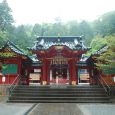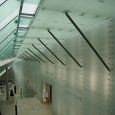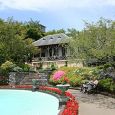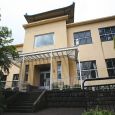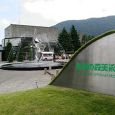Hakone
Advertisement
By plane
The nearest airports to Hakone are in Tokyo. Note that if you have a reservation at a ryokan in Hakone, unless your plane lands in the morning, it is recommended that you spend your first evening in Tokyo or Yokohama, or else you might miss out on (and be charged for) dinner at the ryokan, or worse, you may be locked out of your room at the ryokan's curfew time, if there is one.
Allow about 2 1/2 to 3 hours to reach Hakone from Narita Airport by train, and about 1 1/2 to 2 hours from Haneda Airport.
By train
The fastest and most expensive method of reaching Hakone from Tokyo is to take a Tokaido Shinkansen Kodama train from Tokyo to Odawara, then transfer to the Hakone-Tozan Line for the run to Hakone-Yumoto (trains operated by Odakyu Railway). The one-way ride lasts one hour with a good connection, and costs ¥3430 but if you use the Japan Rail Pass, you need only to pay ¥300 for the Hakone-Tozan line.
Be aware that the JR East Rail Pass does not provide access to the Tokaido Shinkansen and to make use of this pass you will need to ride the regular Tokaido Main Line to Odawara. From Tokyo, a convenient choice that is valid with the JR East Pass is the "Odoriko" limited express train service. These trains have bigger windows and better seating than the regular commuter trains, and seat reservations can be made. As of March 2007, there are at least four daily runs, arriving in Odawara one hour later; there may also be additional runs on certain days. All trains make a pickup stop at Yokohama, while a few also stop at Shinagawa and Kawasaki stations.
Advertisement
The Hakone Open Air Museum
The Hakone Open Air Museum (Japanese: Hakone Chokoku No Mori Bijutsukan), successfully attempts to create a harmonic balance of nature and art by exhibiting various sculptures on its spacious grounds in combination with beautiful views of the surrounding valley and mountains.
Besides the sculptures, the Hakone Open Air Museum features various indoor galleries, including a sizable Picasso Collection, consisting of paintings, prints, sculptures and ceramic creations.
POLA Museum
The POLA group, a skin care and beauty products company, opened the POLA Museum of Art in 2002 in order to display the extensive private art collection of the company's late owner, Suzuki Tsuneshi.
The museum was built amid a forest of 300 year old beech trees, and although constructed of concrete and glass, it is designed so as not to disrupt the natural environment that surrounds it. To achieve this, the majority of the building is located underground.
The museum features modern and contemporary paintings, sculptures, ceramics and glassware by mostly Japanese and European artists. In addition to temporary exhibits, the museum displays rotating exhibits drawn from its permanent collection which include works by artists such as Cezanne, Monet, Picasso and Renoir.
Hakone Shrine
Hakone Shrine stands at the foot of Mount Hakone along the shores of Lake Ashi. The shrine buildings are hidden in the dense forest, but are well advertised by its huge torii gates, one standing prominently in the lake and two others over the main street of Moto-Hakone.
A path leads from the torii gate in Lake Ashi up a series of steps flanked by lanterns through the forest to the main building of the shrine, which sits peacefully among the tall trees. The shrine is beautiful throughout the year, and is particularly breathtaking when shrouded in mist.
A second shrine, Hakone Shrine Mototsumiya ("original shrine") stands at the summit of Komagatake, one of Mount Hakone's multiple peaks. It is accessible by the Komagatake Ropeway from Hakone-en or via hiking trails.
Hakone Botanical Garden of Wetlands
The Hakone Botanical Garden of Wetlands is a botanical garden in the highlands of Fuji Hakone Izu National Park. The park was founded in 1976 as a place to preserve and exhibit over 1700 varieties of marsh and alpine plants native to Japan.
The garden offers a network of boardwalk paths through different types of marshland where you can learn about the plants that populate the wetlands. Information signs are in English and Japanese. The garden is popular during June when its Nikko Kisuge are in full bloom, however it is closed during the winter months.
Hakone Museum of Art
The Hakone Museum of Art, located in Gora, was founded by Okada Mokichi in 1952. Its sister museum, the MOA Museum of Art was later built in Atami City on the Izu Peninsula.
The museum displays mainly Japanese ceramics from prehistoric times through the Edo Period (1600-1868). These include a number of large earthenware and ceramic vessels such as a haniwa burial statue classified as an Important Cultural Property.
Hakone Detached Palace
Hakone Detached Palace used to serve as a summer palace for the Imperial Family, but was later opened to the public. It is located at the southern shores of Lake Ashi on the peninsula between Moto-Hakone and Hakone-machi.
The relatively small and simple palace building is surrounded by a beautiful park, which offers nice walking trails and scenic views of Lake Ashi and Mount Fuji, if visibility permits. Visibility tends to be better during the colder seasons of the year than in summer, and in the early morning and late evening hours.
Gora Park
Gora Park is a western style landscape park located on the steep slope above Gora Station. It is a relaxing place to unwind and enjoy the scenery and views of Hakone.
Gora Park is primarily a French styled landscape park featuring a large fountain and a rose garden. The park also has two greenhouses, one housing a tropical botanical garden while the other contains a flower garden. Additionally, there is a restaurant overlooking the main fountain, as well as the Hakuun-do Chaen teahouse.
In the Crafthouse visitors can take part in craft activities such as glass blowing, glass etching, pottery and dried flower arrangement. Activities range in cost from 1000 to 3500 yen and take from 30 minutes to an hour to complete.
Hakone Glass no Mori
The Hakone Glass no Mori features Italian styled buildings housing a museum and shops. Outside is a large strolling garden surrounding a canal like pond. The garden has a number of large glass sculptures laid about it, as well as a cafe with an open terrace at one end where live canzoni performances are held.
The Glass no Mori's Venetian Glass Museum houses a collection of over 100 pieces of Venetian glassware. It displays both modern and classical works in all forms including vases, goblets, lamps and sculptures.
The Hakone Glass no Mori is run by the Ukai Group, an operator of themed high class restaurants, which also owns the Kawaguchiko Music Forest at Kawaguchiko in the Fuji Five Lakes region.
April - November
Information not available
Advertisement

